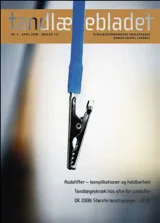Effekten af rodstiftens dimension, elasticitetsmodul og adhæsive binding på spændingsdannelsen i tænder
Holdbarheden af tænder restaureret med rodstifter afhænger af et væld af faktorer. Finite element (FE) -analyse er et softwareværktøj, der anvendes til beregning af spændingsfordeling i komplekse strukturer, også tandrestaureringer. Formålet med denne undersøgelse var at analysere effekten af rodstiftens diameter, længde, elasticitetsmodul og adhæsive binding på spændingsdannelsen i en tand restaureret med en rodstift, opbygning og guldkrone. Der konstrueredes en axisymmetrisk tredimensionel model, der omfattede dentin, parodontalmembran, kortikal og trabekulær knogle, gingiva og guttaperka. Som kontrolrodstift valgtes en cylindrisk titanstift med en diameter på 1,4 mm, længde i rodkanalen på 10 mm og elasticitetsmodul på 112 GPa. Rodstiften blev simuleret til enten at være adhæsivt bundet eller ikkeadhæsivt bundet til dentinen i rodkanalen. Guldkronen blev belastet med 100 N, og de resulterende spændinger i roden blev beregnet og angivet i form af von Mises spændinger. Spændingerne i roden aftog, i takt med at rodstiftens diameter øgedes, eller i takt med at stiftens elasticitetsmodul øgedes. Rodstiftens længde havde ingen indflydelse på spændingsdannelsen i roden. Adhæsiv binding resulterede i mindre spændingsdannelse end konventionel, mekanisk forankring.
Stresses in post-restored teeth: effect of diameter, length, elastic modulus and bonding of the post: Longevity of posts and cores depends on a multitude of factors. Finite element (FE) analysis is a powerful tool in calculating stress distribution in complex structures. The purpose of this study was to analyze the effect on stress formation in post restored teeth of diameter, length, elas tic modulus, and adhesive bonding of posts. The model of the post restored tooth involved dentin, periodontal ligament, cortical and trabecular bone, gingiva, and gutta percha. The control post was a cylindrical titanium post with diameter 1.4 mm, length in root 10 mm, and elastic modulus 112 GPa. The post was cemented with adhesively bonded or non bonded resin cement. The restoration included a resin composite core and a gold crown. The model was axisymmetrical in three dimensions. A load of 100 N was applied to the crown, and the von Mises stresses generated in root dentin were calculated. The stresses in the root decreased as the elastic modulus or the diameter of the post increased. Adhesive bonding of the post accentuated the stress reducing effects. Increasing the length of the post had no significant effect on the stress generated in the root. Within the limitations of this study it was concluded that elastic modulus, diameter, and adhesive bonding of posts influence the stresses generated in the root of post restored teeth.


